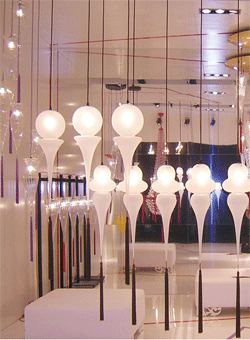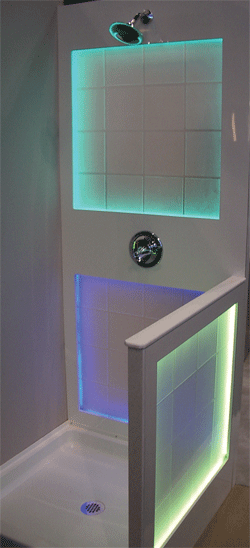Already transforming general lighting, LED-based systems may also radically change architectural electrical design
BY DON MULVEY
ROAL Electronics
Los Angeles, CA
http://www.roallivingenergy.com
LED-based lighting systems are poised to evoke a transformation in the future of general lighting, and may even pave the way for radical changes in building electrical design. To truly deliver the promised efficiency, reliability, and performance benefits of solid-state lighting (SSL), the end-to-end design of the lighting system must be carefully evaluated.

Fixture designers and lighting engineers would be wise to embrace Thomas Edison’s approach that made his invention world renowned and sustainable. In 1882, Edison demonstrated a lighting system that featured reliable central power generation, efficient power distribution, and a successful end use item; the light bulb. Edison’s solution prevailed because he delivered a sustainable system. LED lighting system design should carefully consider the whole and ascertain the best architecture before venturing into the design.
A lighting system integrates power source and distribution systems with a light engine, optics, and control, either manual or electronic. The light engine and optics are always part of the lighting fixture, but there is a fair degree of freedom regarding the placement of the remaining elements.
The most familiar component is the light fixture itself, or luminaire. Traditionally more art than technology, luminaires are the personalized pieces of a lighting system that define ours or a public space for all to enjoy. Designing with LEDs challenges the artisan in that electronics and thermal management must enter the traditional space of bulbs, sockets, metal tubes, wooden carvings and crystal.
The biggest difference between traditional lighting and LED-based systems is the need for well-controlled dc power at the light engine. Incandescent, CFL, halogen, and other light sources are essentially analog devices where a single filament or gas tube is sized to scale the magnitude of the light source.
Conversely, LEDs are finite elements that need to be multiplied to scale the magnitude of the light source, effectively forming a common building block. The added benefits of 0% to 100% controlled dimming and color mixing push them beyond the reach of florescent solutions although they share similar efficiencies.
In a dimmable white-LED-based lighting fixture, electrical power passes through no fewer than three conversion steps. After the PFC circuit rectifies and boosts the ac line to a higher voltage, a second conversion step isolates the primary ac from the rest of the system and provides a regulated dc voltage that is within safe limits. This voltage in turn is converted into pulses of current to control the brightness of the LEDs.
LED-based lighting systems present both opportunity and challenge to lighting system designers. Electrically, they are closer in design to fluorescent or HID lights because of their need for power conversion, and their small size and unlimited control characteristics make them suitable for use in applications where incandescent and halogen lamps are typically used.
Good electrical design dictates that the PFC and dc/dc converter reside in the same physical space, either within the lighting fixture, or external to it. The PWM LED driver should remain as close to the LEDs as possible.
A distributed ac architecture fits nicely into most commercial and residential buildings. Local codes are in place and understood, and wiring, terminations and tools are easy to find. Each individual LED lighting fixture can be implemented as a fully integrated lamp with PFC, dc/dc converter, and PWM dimmer as part of the same assembly.
This approach seems reasonable because it is easily recognizable and fits within existing building electrical systems, yet it places a significant burden on each light fixture as there may be limited space for all of the power electronics. Maintenance and repair is another consideration, as a distributed ac system requires many individual ac/dc converters. This complexity works against the system’s reliability in terms of MTBF.
Luminaires are often hardwired into the building infrastructure, and consumers are accustomed to simply replacing bulbs, so making each subsystem a field-replaceable unit may not be practical from an aesthetic or economic point of view. In addition, each lamp would be susceptible to ac transients and other electrical issues, and building in the proper margins of design protection may prove difficult for smaller lamps and fixtures.
An alternative approach is a distributed dc architecture where a front-end ac/dc supply provides low-voltage dc to the lamps. The requirements for electronics in the lamp would be reduced to the PWM driver and the LEDs, both of which can be implemented with silicon devices so miniaturization and high reliability is possible.
The lighting system’s ac/dc power supply could be designed for higher efficiency, economy, and reliability. In an ac distribution system each subsystem poses a risk of failure. A single ac/dc power module also improves the economic factors related to power factor correction.
There are many other benefits that could be realized through a distributed DC architecture for lighting systems beyond reliability and efficiency. Adding battery backup to the system would provide uninterrupted lighting and emergency lighting features cost-effectively. This type of distribution system based on an SELV low voltage DC can now be designed intrinsically safe.

Low-voltage dc-based LED lighting systems can be made intrinsically safe.
The power conversion and control portion of an LED lighting system makes up the majority of the electronics, as well as the majority of the technical challenges associated with the design of a practical lighting system. The entire power conversion path and its associated hardware must be carefully considered in order to deliver the true value of an LED-based lighting system. There are many lighting applications that warrant a completely integrated system that includes ac/dc conversion in the luminaire.
For general in-building lighting, a distributed DC architecture may speed the delivery and acceptance of the technology with its intrinsic technical qualities. The lessons learned by Edison should be heeded. The desire to launch new products based on fundamental qualities and benefits is undeniable, but lighting manufacturers would be well-served by a holistic view of the lighting system, and the building subsystem in which their fixtures are employed.
Advertisement
Learn more about ROAL Electronics





